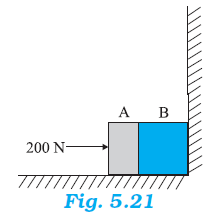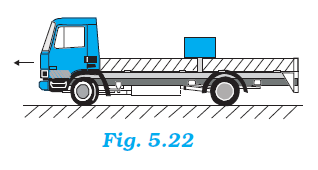Two bodies A and B of masses 5 kg and 10 kg in contact with each other rest on a table against a rigid wall (Fig. 5.21). The coefficient of friction between the bodies and the table is 0.15. A force of 200 N is applied horizontally toA. What are
(a) the reaction of the partition
(b) the action-reaction forces between A and B?
What happens when the wall is removed? Does the answer to (b) change, when the bodies are in motion? Ignore the difference between μs and μk.

Mass of body A, mA = 5 kg
Mass of body B, mB = 10 kg
Coefficient of friction, μs = 0.15
The force of friction is given by the relation,
fs = μ (mA + mB)g
= 0.15 (5 + 10) × 10
= 1.5 × 15
= 22.5 N, leftward
Net force acting on the partition = 200 – 22.5
= 177.5 N, rightward
According to Newton’s third law of motion, the reaction force of the partition will be in the direction opposite to the net applied force.
Hence, the reaction of the partition will be 177.5 N,directed leftwards.
(b)
Force of friction on mass A, fA = μmAg
= 0.15 × 5 × 10
= 7.5 N leftward
Net force exerted by mass A on mass B = 200 – 7.5 = 192.5 N, rightward
Now, according to Newton’s third law of motion, an equal amount of reaction force will be exerted by mass B on mass A.
i.e., Net force acting on mass A by mass B= 192.5 N acting leftward.
When the wall is removed, the two bodies will move in the direction of the applied force.
Net force acting on the moving system = 177.5 N
The equation of motion for the system of acceleration a, can be written as,
Net force = (mA + mB) a
∴ Acceleration, a =

=

Net force causing mass A to move,
FA = mAa
= 5 × 11.83
= 59.15 N
Net force exerted by mass A on mass B = 192.5 – 59.15 = 133.35 N
This force will act in the direction of motion.
According to Newton’s third law of motion, an equal amount of force will be exerted by mass B on mass A, i.e., 133.3 N, acting opposite to the direction of motion.








 s from the start.
s from the start.  )2
)2  rev/min, and has a radius of 15 cm. Two coins are placed at 4 cm and 14 cm away from the centre of the record. If the coefficient of friction between the coins and the record is 0.15, which of the coins will revolve with the record?
rev/min, and has a radius of 15 cm. Two coins are placed at 4 cm and 14 cm away from the centre of the record. If the coefficient of friction between the coins and the record is 0.15, which of the coins will revolve with the record? rev/min
rev/min
 rev/s
rev/s